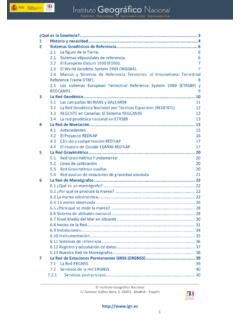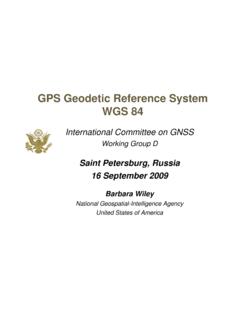Transcription of NAVSTAR, the Global Positioning System: A Sampling of Its ...
1 NAVSTAR, the Global Positioning system : A Sampling331of its Military, Civil, and Commercial ImpactchApter 17 NAVSTAR, the Global Positioning system : A Sampling of Its Military, Civil, and Commercial Impact rick W. Sturdevant Historical Background the nAvStAr1 Global Positioning system (GpS), the first satellite navigation system that enabled users to determine precisely their location in three dimensions and time within billionths of a second, grew from a concept into a fully operational system in slightly more than two is not to suggest, however, that selling the idea was early as 1969 1970,Aerospace corporation president and GpS pioneer ivan Getting had suggested to lee duBridge, president richard nixon s science advisor.
2 That a presidential commission be created to review how satellite navigation ought to proceed, because there were so many potential users. After thinking about it for several weeks, duBridge concluded that execution of Getting s proposal would be too difficult. he told Getting, there are too many people, too many bureaucracies, too much politics, and too many agencies involved. Why don t you just have the Air Force develop it the way we always did? 2 By 1972, both the Force (uSAF) and the navy had been studying for several years the possibility of improved satellite-based radio navigation.
3 Three earlier space-based navigation systems or programs contributed to GpS:the Johns hopkins university Applied physics laboratory (Apl) transit, otherwise known as the naval navigation Satellite system ; the naval research laboratory s timation satellite program, led by roger easton; and uSAF project 621B. colonel Bradford 1. over time, some people identified nAvStAr as an acronym derived from either navigation Signal timing and ranging or navigation Satellite timing and ranging. Apparently,trW had once advocated a navigational system for which nAvStAr was an acronym (nAvigation system timing And ranging).
4 Bradford W. parkinson, GpS eyewitness:the early years, GPS world 5 (9 September 1994): pp. 32 45, explained that his team at the Joint program office never considered nAvStAr an acronym but simply a nice-sounding name. 2. Jacob neufeld, ed., Research and Development in the United States Air Force (Washington, dc: center for Air Force history, 1993), pp. 91 92. 332 SocietAl impAct oF SpAceFliGht parkinson, uSAF director of the newly formed multi-service Joint program office (Jpo) for GpS,assembled about a dozen members of the Jpo over labor day weekend in 1973 and directed them to synthesize the design for a new satellite navigation system by drawing the best ideas and technology from everything then From that point, GpS developed at a reasonably steady pace.
5 By June 1974, the Jpo had selected rockwell international as the satellite contractor. the Jpo oversaw deployment of the initial control segment at the Army s yuma proving Ground in Arizona, followed by the launch of the first operational prototype in February 1978. eleven years later, in February 1989, the uSAF launched the first fully operational Block 2 version. Although a complete constellation of 24 Block 2 satellites existed in december 1993, GpS did not officially achieve full operational status until April 1995.
6 It had cost $10 $12 billion to field the system , and the uSAF estimated the cost annually of sustaining minimal GpS services at $400 the main reasons for GpS development were the need to deliver weapons precisely on target and to reverse the proliferation of navigation systems in the military. From the beginning, however, the department of defense (dod) recognized the usefulness of GpS to the worldwide civilian withhold full accuracy from enemies but provide GpS service to civilian users, the uSAF designed the system with a protective feature called selective availability (SA) that, when used, gave the military and its allies significantly more precise satellite signals than what other users received.
7 After Korean Airline Flight 007 went astray in September 1983 and Soviet fighters shot it down, president ronald reagan reassured the world that the coarser signal would remain continually and universally available at no cost once GpS became fully operational. As GpS approached that status in the early 1990s, civilian and commercial users, who already had 10 times as many GpS receivers as the military, mounted an increasingly vocal campaign for unrestricted access to the more precise satellite signals.
8 Many GpS equipment manufacturers, anticipating a multitude of applications, had begun forming strategic alliances with outside companies in such fields as communications, Geographic information Systems (GiS), computing, and transportation. Finally, in may 2000, president William clinton acknowledged the Global utility of GpS and directed immediate discontinuation of SA, thereby giving millions of nonmilitary users access to the more precise GpS 3. Bradford W. parkinson, introduction and heritage of nAvStAr, the Global Positioning system in Global Positioning System: Theory and Applications,Volume I, Bradford W.
9 Parkinson and James J. Spiker, Jr., ed. (Washington, dc: American institute of Aeronautics and Astronautics, 1996), pp. 3 28; ivan A. Getting, All in a Lifetime: Science in the Defense of Democracy (new york:vantage press, 1989), pp. 574 599; richard easton, Who invented the Global Positioning system ? The Space Review (22 may 2006), http://www. (accessed 12 September 2006). 4. michael russell rip and James m. hasik, The Precision Revolution: GPS and the Future of Aerial Warfare (Annapolis, md: naval institute press, 2002), pp.
10 68 79. 5. parkinson, GpS eyewitness, pp. 42 44; rip and hasik, The Precision Revolution, pp. 9 10 and 429 441; Anthony r. Foster, GpS Strategic Alliances, part i: Setting them up, GPSW orld 5 (5 may 1994): pp. 34 42; national research council,The Global Positioning system A Shared National Asset: Recommendations forTechnical Improvements and Enhancements (Washington,dc:national Academies press,1995), 12. 333 NAVSTAR, the Global Positioning system : A Sampling of its Military, Civil, and Commercial Impact With increasing demand for accuracy beyond what GpS alone yielded, users found ways to augment it.









